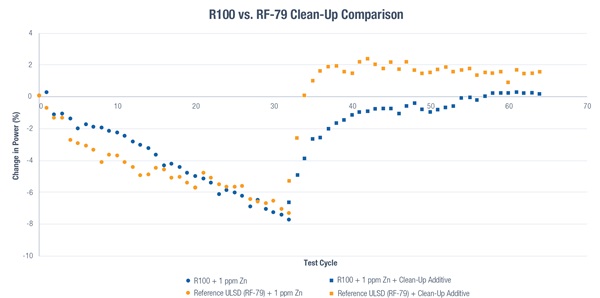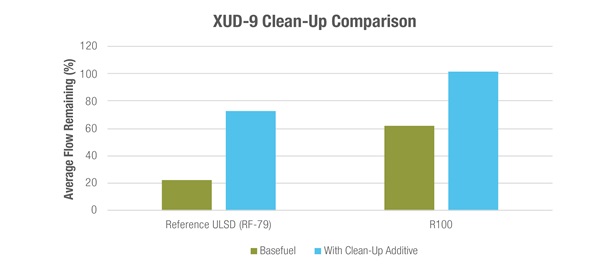Part one of this series covered why hydrogenation-derived renewable diesel (HDRD) is gaining market adoption for its advantages versus first-generation biodiesels and ultra-low sulfur diesel (ULSD) fossil fuels. The trend is especially true in the U.S. market, where, absent a density limitation in the ASTM D975 specification, HDRD finds use as a direct “drop-in” for ULSD.
Notable HDRD Benefits
- High natural cetane number
- Good low-temperature operability with winter grades
- Potential for lower emissions
- Reduced injector deposit formation
- Greater oxidation stability
But HDRD, or HVO (hydrogenated vegetable oil) as it is also commonly known, isn't without its challenges.
Like ULSDs, unadditized HVO can also have issues with injector-deposit-induced fuel consumption increases and water entrainment tendency. HVOs also have poor natural lubricity and conductivity that can lead to potential equipment operation issues if the fuel is left untreated. Furthermore, while paraffinic type fuels such as HDRD are stable, mixing with other less stable materials within real-world supply chains could give rise to stability and deposit issues because they are less capable of dissolving polar materials.
For these reasons, it is our view that multifunctional diesel fuel additives are still very much needed for HDRD, at a minimum, to prevent potential issues with fuel injector deposits, corrosion and water entrainment.
A closer examination and results from recent nozzle coking tests offer examples as to why.
DW10B Test Results
Developed in Europe, the CEC F-98-08 DW10B engine test is considered the industry's standard method assessing nozzle fouling tendencies of fuels and fuel additives. The CEC test method requires that a zinc (Zn) foulant is added to the fuels tested. Without zinc, the test is not anticipated to show fouling severity as seen in the field.
Running multiple tests in this way reveals the importance of deposit control additives in renewable diesel, whether using a fuel including blended HVO or pure HVO itself.
R30 Blend Tests
The chart below shows a DW10B completed with R30 fuel (30% renewable diesel blended with RF-79 petroleum diesel). With 1 ppm Zn, the R30 fuel had -7.3% power loss. Deposits were removed and power restored with the addition of a clean-up fuel additive.

R100 Tests
A separate set of DW10B tests using R100, or pure renewable fuel, showed similar results.
We ran untreated R100, using 1ppm Zn as a foulant. This test was compared to reference ULSD, RF-79, and showed an R100 power loss (-7.8%) comparable to severe RF-79 petroleum diesel.

XUD-9 Test Results
The conventional CEC F-23-01 XUD-9 test method is a single keep-clean procedure to measure carbonaceous deposit formation.
Though an older engine technology, XUD-9 engine testing remains relevant as it is the only engine test that does not require a foulant, such as zinc, to create deposits. This makes the XUD-9 test a valuable cross-check for DW10B results.
When reviewing the results below, it is important to recognize that R100 HDRD/HVO renewables are, in fact, very clean fuels. We can see this as the untreated R100 presents a significantly higher flow remaining compared to the untreated RF-79 sample following testing. Although carbonaceous deposits are still formed, they are formed at a much lower level than mineral-only fuel.
However, even though carbonaceous deposit formation levels are lower with HDRD/HVO, they are still present, and the use of deposit control additives therefore can be seen to remain beneficial in controlling and removing deposits.

Our View
Renewable diesel is a drop-in fuel that’s typically more acceptable to OEMs than FAME (Fatty Acid Methyl Ester) type biodiesel and capable, through responsible sourcing and manufacture, of greatly lowering the global warming potential of fuels such as ULSD products. However, as evidenced by the test data above, and just like with other fuels, certain classes of additives are critical to unlocking the full potential of HDRD/HVO fuels, enabling engines to deliver long-term sustained performance with these fuels.
Renewable fuels should therefore be treated with appropriate additives to protect fleets and consumers alike from issues such as continuous power loss or downtime due to other complications from deposit formation.
To continue to educate end-users on this often-complicated topic, we have created a series of articles to share on Lubrizol 360 discussing how to improve the performance of HDRD and more. Be on the lookout for part III in the coming months.
For more information about diesel fuel additives, please contact your Lubrizol representative.









